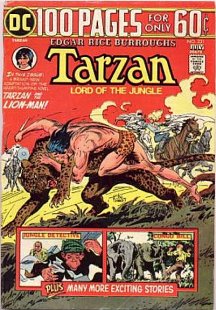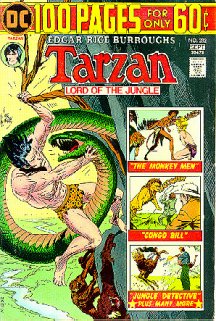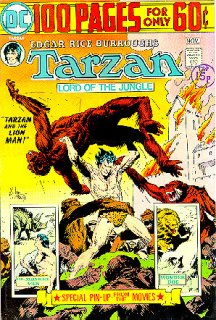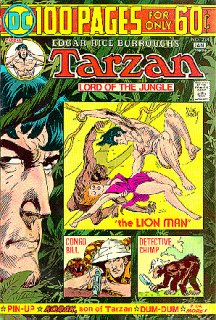Burroughs does a remarkable thing
in this ring that clearly shows the Greek classical influence per Erling
Holtsmark in his Tarzan and Tradition. ERB dissolves his story
and cast of characters after the last Bansuto attack. The cast
is dispersed in several directions but ERB will deliver them all to Omwamwi
Falls as he begins the three right hand rings: 3-2-1.
In fact this does follow the Homeric tradition.
The story of the Trojan Wars was actually a massive story of which only
three parts survive, the Iliad which concerns the central part of
the epic and the two Returns, The Odyssey and the Oresteia.
All the rest has been lost or survives only in fragments such as the "Judgement
Of Paris." Originally the epic was thousands of pages long.
There were undoubtedly but few scholars who had ever read the story in
its entirety and fewer still who understood it.
It seems incredible that a very young ERB could
have grasped the structure so completely while seeming to understand it
so thoroughly. Holtsmark quotes ERB as saying that he was rereading
Plutarch's Lives in 1923 when he rediscovered that Numa was the
name of a Roman emperor, actually one of the Republican kings. To
that point he had believed that he had made up the name.
Thus we learn that ERB did some rereading and
that his subconscious supplied material. He could have, it is plausible,
read the Iliad and Odyssey a number of times over his life.
Along with other classical reading the basic method was established in
his subconscious which he was able to consciously manipulate.
The Trojan War was the first of the three great
sprawling European epics, unmatched in any other literature.
The second was the Arthurian Saga also huge
sprawling through many thousands of pages. That story has its roots
in Greek mythology as well as in the Christian ethos. The Lancelot-Grail
alone is several thousand pages. Burroughs doesn't seem to have been
much concerned with it. Indeed, most of it would have been untranslated
in his time thus being unavailable to him.
The third great cycle was the strange nineteenth
century English pursuit of the Grail of the search for the source of the
Nile. In my estimation a rather peculiar obsession. This story
too occupies several thousands of pages as all of the participants recorded
their efforts in copious detail. Livingston, Stanley, Burton, Baker
and Speke have written magnificent narratives. Speke walking the
Nile North after just having discovered the source actually ran into Baker
following the Nile South. A remarkable accidental encounter that
goes unnoticed.
The best overview and history of the quest
is Alan Moorehead's The White Nile of 1960. He provides an
adequate background for these modern knights in search of an unlikely Grail.
The Tarzan oeuvre might be included as a fourth cycle based on cycles one
and three.
The first and third epics then involved ERB
intimately. The Tarzan series is based on the Africa of the Nile
Quest while framed in the literary construction of the first.
Burroughs then dissolves his story after the
Bansuto attack then telling the story of the several participants in the
manner of the Homeric Returns. He then reassembles them less Obroski
at the Omwamwi or Murchison Falls on the Nile. Thus the river cascading
from the plateau is actually the Nile. What he calls the Thames on
the plateau of the City of God must be indeed a substantial stream.
We have already dealt with the fate of Stanley
Obroski and Tarzan. After the last Bansuto attack the Arabs agreed
to take the midnight to six watch. During the night they folded their
tents and silently stole away taking Rhonda, Naomi and the map with them.
Orman decides to go off in pursuit of them
alone. Bill West convinces him to take himself along so the two abandon
the safari to pursue the girls and Arabs.
Tarzan neutralizes the Bansuto by having them
promise to be kind to Whites so the remaining safari members are able to
somehow get their trucks and equipment to the falls unmolested. That
leaves the girls, the Arabs and Orman and West.
After leaving Obroski shivering with fright
in a tree Tarzan comes upon Orman and West as they are being attacked by
a lion. Plummeting from a tree Tarzan dispatches the lion immediately
disappearing into his tree. This is the first incident of the cast
mistaking Tarzan for Obroski. I happen to think Burroughs handles
this confusion extremely well. After all, Burroughs has firmly established
Obroski's cowardice with the safari members.
Orman and West's astonishment at the seeming
Obroski feat is very genuine. Later when Tarzan supplies them with
a buck while translating Arabic from Atewy their astonishment can't be
more complete. Very effectively handled. Having supplied them
with food Tarzan points them in the right direction and gets them started
with a swift kick so that leaves the Arabs and the girls to account for.
This also begins the comparison of the qualities of Rhonda and Naomi.
The Arabs have the map to the valley of diamonds
they believe to be genuine as indeed it is. Unable to read English,
the language of the map, they make promises of freedom to gain the cooperation
of the girls. Rhonda scoffs at the genuineness of the map believing
it only a movie prop. However they can locate their position according
to the landmarks provided by the map. Astonishingly they are
able to locate all the landmarks which lead them to the Omwamwi Falls.
Naomi accepts her captivity while Rhonda plans
escape. She effects this by saddling a couple ponies at night while
driving the herd off. This episode is also well handled and quite
believable given that this is a fantasy novel. The net result is
that Naomi is recaptured while Rhonda makes it to the Falls where the story
is forwarded as she is captured by the Apes of God. Another little
joke, I presume.
Following both the map and Rhonda the Arabs
and Naomi arrive at the Falls. The action then finishes the parallel
story to Tarzan and Obroski of the girls and begins the right second ring
story of The City Of God.
This is a magnificent story full of many twists
and surprises. In our day this stuff has been used over and over
so that the imaginative feat is diluted or lost. If one places one's
imagination back in 1933 one can marvel while seeing how disappointed ERB
was that the novel fell flat. Such is life.





![]()
